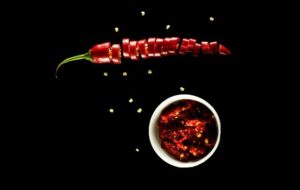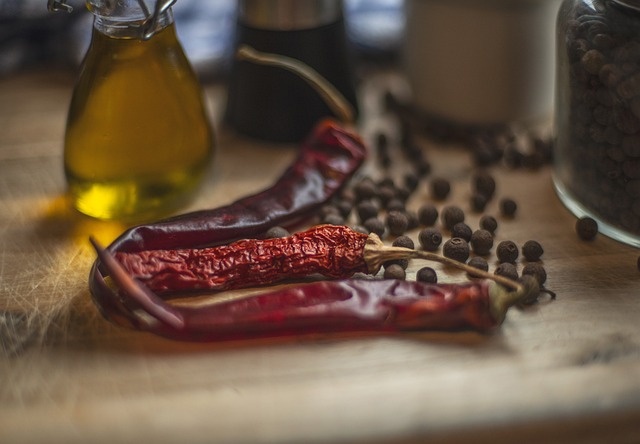Scoville units scale is what helps us understand why one chilli feels mild while another can leave us gasping for water. We’ve all had that surprise moment when a tiny green chilli turns out hotter than expected.
This scale measures the heat of chillies in a clear, scientific way so we can tell which varieties are gentle and which ones pack a serious punch — whether we’re growing them in our garden or cooking with them in the kitchen.
WHAT IS THE SCOVILLE UNITS SCALE?
The Scoville units scale measures the heat or pungency of chilli peppers and other spicy foods. It tells us how much capsaicin — the chemical compound responsible for the burning sensation — is present in a pepper.
The higher the Scoville number, the hotter the pepper. For example, a bell pepper has zero Scoville Heat Units (SHU) because it contains no capsaicin, while the famous Bhut Jolokia or Ghost Pepper can reach over 1,000,000 SHU.
This simple number gives gardeners, chefs and spice lovers a common way to compare the heat level of different chillies.
THE MAN BEHIND THE SCALE
The scale was developed in 1912 by Wilbur Scoville, an American pharmacist. He worked for the Parke-Davis pharmaceutical company and was tasked with finding a way to measure the strength of pepper extracts used in medicinal creams.
Scoville came up with a clever method: he diluted chilli extract in sugar water and asked testers to sip it. The dilution continued until the heat was no longer detectable. The more dilution required, the higher the heat level.
For example, if a chilli needed to be diluted 1,000 times before it lost its heat, it scored 1,000 Scoville Heat Units.
This process was called the Scoville Organoleptic Test. While it was subjective — because it relied on people’s taste buds — it laid the foundation for modern chilli heat measurement.

MODERN SCIENCE BEHIND THE SCALE
Today, we don’t rely on taste testers to measure heat. Modern laboratories use High-Performance Liquid Chromatography (HPLC) to measure capsaicin levels precisely.
This method identifies the exact concentration of capsaicinoids, the chemical compounds that make chillies hot. The results are then converted into Scoville Heat Units to keep consistency with the original scale.
This gives us a more accurate, scientific way to measure heat while still respecting Scoville’s original idea.
WHY THE SCOVILLE SCALE MATTERS
If you grow or cook with chillies, understanding the Scoville scale is incredibly useful. It helps you decide which varieties to plant, how to handle them, and even how to pair them in recipes.
For gardeners, it’s a guide to choosing the right level of heat. Beginners might start with mild chillies like Banana Pepper or Anaheim, while experienced growers may experiment with fiery ones like Trinidad Scorpion or Carolina Reaper.
For cooks, it helps in adjusting spice levels without ruining a dish. Knowing the Scoville rating helps maintain flavor balance instead of ending up with something too hot to eat.

HOW SCOVILLE UNITS ARE MEASURED
Capsaicin concentration determines Scoville value. Capsaicin binds to pain receptors in our mouth and skin, which send signals to the brain that we interpret as heat.
When measured in a lab, chillies are dried and tested for their capsaicinoid content. The results are translated into Scoville Heat Units.
For example:
- 0 SHU – Bell pepper
- 1,000 SHU – Mild paprika
- 5,000 SHU – Jalapeño
- 100,000 SHU – Bird’s eye chilli
- 1,500,000+ SHU – Carolina Reaper
This makes it easy to visualize the difference between mild, medium, and extremely hot chillies.

FACTORS THAT AFFECT HEAT LEVELS
Not all chillies of the same type are equally hot. Several factors influence the final Scoville rating of a pepper, including:
- Growing Conditions – Soil type, sunlight and watering frequency affect capsaicin production.
- Ripeness – Fully ripe peppers tend to have more heat than unripe ones.
- Genetics – Hybrid and cross-pollinated plants can have varying heat levels.
- Climate – Warmer climates usually produce hotter chillies.
- Stress – Plants that experience water stress or pest attacks sometimes develop more capsaicin.
So, if your homegrown chillies feel hotter than store-bought ones, your garden might be creating ideal “stress” conditions.
HOW TO HANDLE HOT CHILLIES SAFELY
When dealing with chillies that rank high on the Scoville units scale, safety matters. The capsaicin oils can irritate skin, eyes, and even lungs if inhaled in powder form.
Here are a few safety tips:
- Wear gloves when cutting or handling super-hot chillies.
- Avoid touching your face or eyes during preparation.
- Wash hands with soap and warm water after handling.
- Use a mask if you’re grinding dried chillies into powder.
- Keep milk or yogurt handy to neutralize accidental burns.
Remember, water doesn’t help with chilli burns because capsaicin is oil-based. Dairy works best because it contains casein, a protein that breaks down capsaicin.

USING THE SCALE IN YOUR GARDEN
If you’re planning a chilli garden, the Scoville scale can help you design it better. You can group chillies by heat level and even experiment with flavor profiles.
For example:
- Grow mild chillies like Poblano or Banana Pepper for stuffing or salads.
- Add medium-heat varieties like Cayenne or Jalapeño for pickling or sauces.
- Reserve a spot for hot chillies like Habanero or Ghost Pepper if you love extreme spice.
Label your plants with their Scoville ratings so you always know what you’re harvesting. This also makes your garden educational for visitors or family members who enjoy learning about plants.
FUN FACTS ABOUT THE SCOVILLE SCALE
- Capsaicin doesn’t actually cause physical burns. It only tricks your brain into thinking you’re in pain.
- Birds are immune to capsaicin. That’s why they can eat chillies without discomfort.
- The hottest part of a chilli is the white membrane inside, not the seeds.
- Some chilli growers compete to create hotter and hotter varieties every year.
- Capsaicin is used in pepper sprays and some pain relief creams.
These small details make the world of chillies even more fascinating.
HOW TO BUILD YOUR HEAT TOLERANCE
If you’re someone who loves spice but struggles with extreme heat, don’t worry. You can build your tolerance gradually.
Start with mild chillies and slowly move to hotter ones. Eating spicy food regularly helps your body get used to capsaicin. You’ll notice over time that what once felt fiery becomes tolerable.
Drink milk instead of water when things get too hot, and always listen to your body. The goal is enjoyment, not discomfort.
THE FUTURE OF THE SCOVILLE SCALE
Scientists are now exploring more precise ways to measure chilli heat. Some are looking into how different capsaicinoids (like dihydrocapsaicin and nordihydrocapsaicin) contribute to varying sensations of heat.
There’s also growing interest in how climate change may affect capsaicin production in chilli plants. With rising temperatures, we might see hotter chillies becoming more common in the coming decades.

FAQs
1. What are Scoville Heat Units (SHU)?
Scoville Heat Units measure the amount of capsaicin in a chilli pepper. The higher the SHU, the hotter the pepper. It gives a standard way to compare different chillies by their heat level.
2. How accurate is the Scoville scale today?
Modern methods like High-Performance Liquid Chromatography make the scale much more accurate than the original taste-based tests. However, natural variations in growing conditions can still affect results slightly.
3. Which is the hottest chilli in the world?
Currently, the Carolina Reaper holds the record as the world’s hottest chilli, reaching over 2,200,000 Scoville Heat Units. It was bred in South Carolina and is known for both its heat and fruity flavor.
4. Why do some people enjoy eating very spicy food?
Capsaicin triggers endorphin release in the brain, which gives a mild “rush” or sense of pleasure. Many people enjoy that thrill and gradually build tolerance to handle hotter chillies.
5. Can chillies lose their heat over time?
Yes, dried or stored chillies can lose some of their capsaicin potency over months. Storing them in airtight containers away from moisture and light helps preserve their heat longer.
Thanks for reading. Keep growing, keep exploring, and don’t forget to return here at gardeningbud.com for more plants, tips and gardening wisdom.
